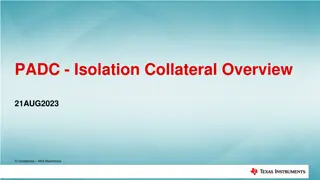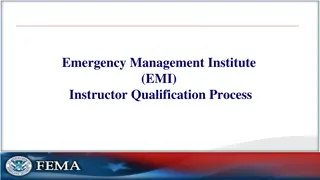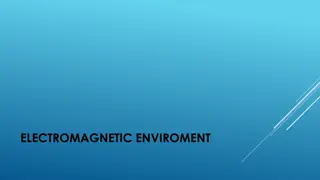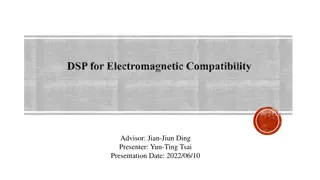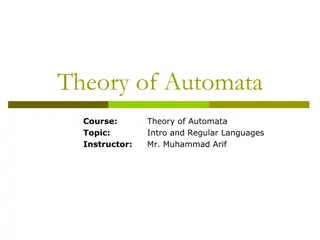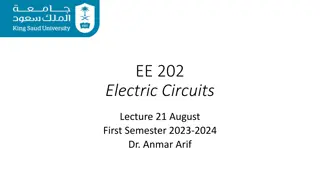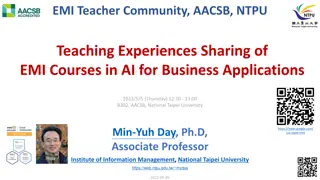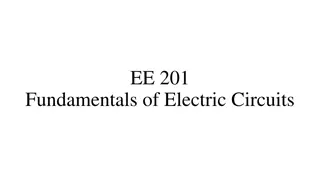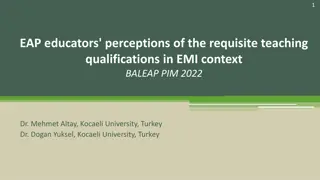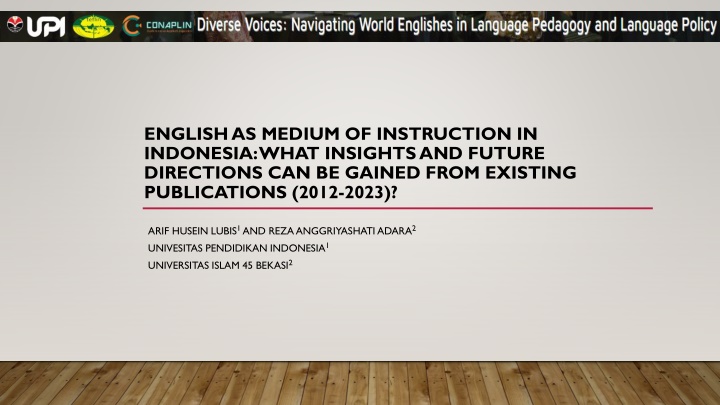
Insights on English as Medium of Instruction in Indonesia: Exploring Trends and Stakeholder Perceptions
Delve into the existing publications (2012-2023) by Arif Husein Lubis and Reza Anggriyashatiadara from Universitas Pendidikan Indonesia and Universitas Islam 45 Bekasi, respectively, to gain insights on the implementation of English as a medium of instruction in Indonesia. Explore trends and stakeholder perceptions regarding EMI, highlighting key themes from a systematic literature review.
Download Presentation

Please find below an Image/Link to download the presentation.
The content on the website is provided AS IS for your information and personal use only. It may not be sold, licensed, or shared on other websites without obtaining consent from the author. If you encounter any issues during the download, it is possible that the publisher has removed the file from their server.
You are allowed to download the files provided on this website for personal or commercial use, subject to the condition that they are used lawfully. All files are the property of their respective owners.
The content on the website is provided AS IS for your information and personal use only. It may not be sold, licensed, or shared on other websites without obtaining consent from the author.
E N D
Presentation Transcript
ENGLISH AS MEDIUM OF INSTRUCTION IN INDONESIA: WHAT INSIGHTS AND FUTURE DIRECTIONS CAN BE GAINED FROM EXISTING PUBLICATIONS (2012-2023)? ARIF HUSEIN LUBIS1AND REZA ANGGRIYASHATIADARA2 UNIVESITAS PENDIDIKAN INDONESIA1 UNIVERSITAS ISLAM 45 BEKASI2
BACKGROUND FOR THIS STUDY Globalization Internationalization of education The presence of EMI programs in EFL countries at schools and HEIs Driving forces English as a global lingua franca viewed as an instructional approach a policy & regulation a learning resource bringing up The need for reviewing empirical results in the last decade to gain insights and figure out future directions of research on EMI in Indonesia Diverse perspectives and practices among teachers and students
REVIEW OF RELATED LITERATURE EMI as a program where English is used as medium of instruction to teach lessons other than English language itself (Macaro et al., 2018) Perceived as a mean to enhance students English proficiency as students immersed with the language through content learning The integration of English at secondary level in 1967 and as one of primary school subjects in 1990 (Bolton et al., 2023) The inception of International Standard School (also known as Rintisan Sekolah Bertaraf Internasional/RSBI) in 2003 due to the increasing demand of English as a MOI (Bolton et al., 2023; Simbolon, 2021) EMI in higher education institutions in Indonesia since 2015 as the Ministry of Research, Technology and Higher Education (RISTEKDIKTI) prepared a curriculum that provides teaching and learning in both Indonesian and English languages (The Jakarta Post, 2015) Several disadvantages of implementing EMI such as insufficient instruction from tutors or lecturers, unsuitable teaching and learning materials, as well as insufficient classroom communication (An, Macaro, & Childs, 2021; Yang et al., 2019) A nation-wide review of previous studies to provide a clearer portrait of this particular issue
OBJECTIVES OF THE PRESENT STUDY 1. To provide the trends of research on the implementation of EMI in Indonesia in the last decade (2012-2023) 2. To elaborate on the findings emerged from the previous studies regarding the stakeholders perceptions and practices of EMI in Indonesia in the last decade
RESEARCH METHODS A mapping analysis and qualitative systematic literature review Using PRISMA (The Preferred Reporting Items for Systematic reviews and Meta- Analyses) model (2015) 65 titles included Using Williams (2015) content analysis process to obtain the findings of the key emerging themes
OBJECTIVE #1: RESEARCH DESIGNS USED Category Sub-category Number of featuring papers Research approach Qualitative 38 Quantitative 10 Qualitative & Quantitative 13 Mixed methods 4 Data collection technique Survey 14 Interview 7 Document analysis 14 Multiple techniques 29 Data sources Students 15 Teachers 18 Students & teachers 32 Level of education being concerned Primary 6 Secondary 22 Higher education 32 Various 5
OBJECTIVE #1: RESEARCH FOCI Research focus Number of featuring papers Research focus Number of featuring papers Students perceptions 14 Teachers motivation and confidence 1 Teachers views 12 Teachers professional competencies 1 Case studies of EMI 11 Teacher training 1 Issues and challenges 5 Teacher talk 1 Students voices 2 Communication strategies 1 Process and outcomes 2 Students competitiveness 1 Program evaluation 2 Teaching content subjects 1 Students language use 1 Language curriculum reframing 1 Students motivation and attitudes 1 Impacts 1 Students speaking anxiety 1 Critical thinking and EMI 1 Language functions 1 Mediating roles 1 Administrative staff s views 1 Common sense and resistance 1
OBJECTIVE #2: EMERGING FINDINGS ON THE STAKEHOLDERS PERCEPTIONS OF EMI For students, it was expected that they could enrich their language and disciplinary knowledge through EMI learning (Muttaqin & Chuang, 2022). For teachers, EMI program was expected to simultaneously provide English learning or open more opportunities to their students in acquiring English during teaching subject (Coleman et al., 2023). Regarding the readiness to implement EMI, there must be tight requirements for both teachers and students. The teachers and students felt fairly confident at using English language in EMI classrooms. The use of English only during the teaching and learning process is partially agreed. Teachers perceived positively on the delivery of teaching materials using translanguaging (Setoningsih, 2022). EMI is generally perceived as a means for making the students stay focused, motivated to improve English skills and academic competence, trained regarding the application of the four skills of English in subject courses, and enriched related to cultural knowledge. While teachers showcase an interest to use English in teaching Science or improvement in speaking skills and content mastery, students consider grasping disciplinary knowledge and understanding learning resources through English is not an easy task. The results also highlight the main concern with Indonesian language skills deterioration, culture shift and identity.
OBJECTIVE #2: EMERGING FINDINGS ON THE STAKEHOLDERS PRACTICES IN EMI PROGRAMS Most teachers inform that they do not apply a strict monolingual approach to teach subject using EMI, instead maximize the potential use of their first language or mother tongue (Qomariah et al., 2022; Sudiatmika, 2013). English is typically used by the teachers for giving examples, explaining new concept, explaining assignments and classroom policy, and leading a discussion (Pramerta, 2023). The analysis results emphasize the incorporation and integration of ICT tools in maximizing the students learning process (Muttaqin & Chuang, 2022). Contextual uses of other languages were also noticed such as the use of Indonesian to ask for clarification, Q&A, or to tell a joke (Pritasari et al., 2018). There were three fundamental challenges during the implementation of EMI among the teachers: (1) English language barriers among the subject teachers (Nasution & Fithriani, 2023); (2) lack of socialization (Zacharias, 2013); and (3) lack of institutional support for professional development (Lamb et al., 2021).
IMPLICATIONS FROM THE CURRENT INSIGHTS The practice and beliefs of EAP-driven corrective feedback in EMI settings among teachers Implementation of team teaching between subject teachers and language tutors in EMI classrooms and its effectiveness in developing students learning outcomes Empirical evidence of cross-fertilisation of EMI and EAP (A discussion paper of this topic available in Galloway & Rose, 2022) The dynamic practices of EMI in schools (e.g., A scoping review available in Gilanyi et al., 2023) The impact of EMI on student academic achievement in under-explored disciplines (e.g., Dafouz & Camacho-Minano, 2016 in accounting) Empirical evidence of the provision of student support during EMI programmes (e.g., Galloway & Ruegg, 2020 in Japan and China)
CONCLUSION The results generally exhibit a growing interest in delving into the stakeholders perspectives and practices of EMI at the school or university level. EMI has been perceived as a means for advancing the international recognition of the institutions since they can invite more international students to pursue secondary or higher education in Indonesia. However, challenges remain mainly on the English language skills of the local teachers to teach subject matters and lack of socialization to implement EMI programs. Research agendas in the coming years can probe more deeply into the multifaceted nature of EMI from cross-fertilization of EMI and EAP to teachers continuous professional development initiatives and its outcomes at the school and higher education institutions.
REFERENCES Coleman, H., Ahmad, N. F., Hadisantosa, N., Kuchah, K., Lamb, M., & Waskita, D. (2023). Common sense and resistance: EMI policy and practice in Indonesian universities. Current Issues in Language Planning, 1-22. https://doi.org/10.1080/14664208.2023.2205792 Dafouz, E., & Camacho-Mi ano, M. M. (2016). Exploring the impact of English-medium instruction on university student academic achievement: The case of accounting. English for Specific Purposes, 44, 57-67. https://doi.org/10.1016/j.esp.2016.06.001 Galloway, N., & Rose, H. (2022). Cross-fertilisation, not bifurcation, of EMI and EAP. ELT Journal, 76(4), 538-546. https://doi.org/10.1093/elt/ccac033 Galloway, N., & Ruegg, R. (2020). The provision of student support on English Medium Instruction programmes in Japan and China. Journal of English for Academic Purposes, 45, 100846. https://doi.org/10.1016/j.jeap.2020.100846 Gilanyi, L., Gao, X. A., & Wang, S. (2023). EMI and CLIL in Asian schools: A scoping review of empirical research between 2015 and 2022. Heliyon, 9, e16365. https://doi.org/10.1016/j.heliyon.2023.e16365 Lamb, M., Hadisantosa, N., Waskita, D., Kuchah, K., & Ahmad, N. F. (2021). The state of English Medium Instruction (EMI) in higher education institutions in Indonesia. British Council. https://www.britishcouncil.id/sites/default/files/the_state_of_english_as_medium_of_ instruction_in_heis_in_indonesia_full_report_final.pdf Muttaqin, S., & Chuang, H. H. (2022). Learning expectations, challenges, and strategies of university students on English-medium instruction. Journal on English as a Foreign Language, 12(2), 272-294. https://doi.org/10.23971/jefl.v12i2.4041 Nasution, A. H., & Fithriani, R. (2023). Indonesian university students and lecturers perceptions of English medium instruction. Eltin Journal: Journal of English Language Teaching in Indonesia, 11(2), 222-234. Pramerta, I. G. P. A., Ratminingsih, N. M., Putra, I. N. A. J., Santosa, M. H., Artini, L. P., & Adnyani, N. L. P. S. (2023). Voices of Non-English Students and Teachers in English as a Medium of Instruction. International Journal of Learning, Teaching and Educational Research, 22(3), 491-509. Pritasari, A., Reinaldo, H., & Watson, C. W. (2019). English-medium instruction in Asian business schools: A case study. Journal of Multilingual and Multicultural Development, 40(1), 1-13. Qomariah, A. R., Driana, E., & Setiadi, H. (2022). Evaluation of the implementation of English medium instruction. Jurnal Penelitian dan Evaluasi Pendidikan, 26(1), 59-71. Setoningsih, D. A. (2022). The secondary education students and teachers perspectives on EMI. English Learning Innovation (englie), 3(1), 17-26. Sudiatmika, I. K., Nitiasih, P. K., & Suarnajaya, I. W. (2017). A case study on the students and teachers perceptions on the use of English as a medium of instruction and teachers professional competencies at SMP Negeri 1 Denpasar. International Journal of Language and Literature, 1(3), 175-183. Zacharias, N. T. (2013). Navigating through the English-medium-of-instruction policy: Voices from the field. Current Issues in Language Planning, 14(1), 93-108. https://doi.org/10.1080/14664208.2013.782797
THANK YOU lubis_ah@upi.edu Very welcomed to questions and comments



